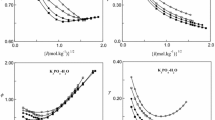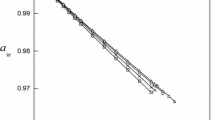Abstract
Osmotic vapor pressure measurements have been carried out for three ternary systems, H2O + 0.2 m 18-crown-6 + LiCl, H2O + 0.2 m 18-crown-6 + NaCl and H2O + 0.2 m 18-crown-6 + KCl at 298.15 K using vapor pressure osmometry. Water activities for each ternary system were measured and used to calculate the activity coefficients of 18-crown-6 (18C6) and its salts following the methodology developed by Robinson and Stokes for isopiestic measurements. In the concentration range studied, it was found that (in NaCl and KCl solutions) there is considerable lowering of activity coefficients of one component in the presence of other solutes that has been attributed to the formation of the complexed 18C6:Na+ (or 18C6:K+) species in solution. The Gibbs energies of transfer of alkali chlorides from water to aqueous 18C6 solutions and that of 18C6 from water to aqueous electrolyte solutions have been calculated. These were further used to evaluate the pair and triplet interaction parameters. The calculation of thermodynamic equilibrium constants using the pair interaction parameter, g NE (i.e., the nonelectrolyte–electrolyte pair interaction) for the studied complexation of cations yields values which are in good agreement with those reported in literature obtained by using ion-selective potentiometry and calorimetry. The results are discussed in terms of water structural effects, complex formation, and hydrophobic interactions.
Similar content being viewed by others
REFERENCES
C. J. Pedersen, J. Amer. Chem. Soc. 89, 2495(1967).
(a)M. Dobler, Chimica 38, 415(1984); (b)F. Vogtle, H. Sieger, and W. M. Mullar, Topics Current Chem. 98, 107(1981);(c)F. Vogtle, W. M. Mullar, and W. H. Watson, Topics Current Chem. 125, 131(1984).
D. J. Cram, Science 240, 760(1988).
K. J. Patil, S. R. Heil, M. Holz, and M. D. Zeidler, Ber. Bunsenges. Phys. Chem. 101, 91(1997).
K. J. Patil, T. M. Kirschgen, M. Holz, and M. D. Zeidler, J. Mol. Liq. 81, 201(1999).
K. J. Patil and R. B. Pawar, J. Phys. Chem. 103B, 2256(1999)
(a)K. J. Patil, R. B. Pawar, and G. S. Gokavi, J. Mol. Liq. 75, 143(1998);(b)R. B. Pawar, Ph.D. Thesis, Shivaji University, Kolhapur, India, 2002.
H. S. Harned and R. A. Robinson, Multicomponent Electrolyte Solutions (Pergamon Press, London, 1968).
F. J. Kelly, R. A. Robinson, and R. H. Stokes, J. Phys. Chem. 65, 1958(1961).
R. A. Robinson and R. H. Stokes, J. Phys. Chem. 66, 506(1962).
V. E. Bower and R. A. Robinson, J. Phys. Chem. 67, 1524(1963)
V. E. Bower and R. A. Robinson, J. Phys. Chem. 67, 1540(1963).
W. Y. Wen and C.-M. Chen, J. Phys. Chem. 73, 2895(1969).
R. A. Robinson and R. H. Stokes, J. Phys. Chem. 65, 1954(1961).
H. D. Ellerton and P. J. Dunlop, J. Phys. Chem. 70, 1831(1966)
J. E. Desnoyers, G. Perron, L. Avedikian, and J.-P. Morel, J. Solution Chem. 5, 631(1976).
M. Y. Schrier, P. J. Turner, and E. E. Schrier, J. Phys. Chem. 79, 1391(1975).
W. F. McDevit and F. A. Long, J. Amer. Chem. Soc. 74, 1773(1952).
W. L. Masterton and T. P. Lee, J. Phys. Chem. 74, 1776(1970).
R. Aveyard and R. Heselden, J. Chem. S. Faraday Trans. I 70, 1953(1974).
F. L. Wilcox and E. E. Schrier, J. Phys. Chem. 75, 3757(1971).
W. McMillan and J. Mayer, J. Chem. Phys. 13, 176(1945).
H. L. Freidman and C. V. Krishnan, in Water: A Comprehensive Treatise, Vol. III, F. Franks, ed. (Plenum Press, New York, 1973).
J. E. Desnoyers, M. Billon, S. Leyer, G. Perron, and J.-P. Morel, J. Solution Chem. 5, 681(1976).
C. V. Krishnan and H. L. Friedman, J. Solution Chem. 3, 849(1974).
W. Y. Wen and J. H. Hung, J. Phys. Chem. 74, 170(1970);(b)_R. Tenne and A. Ben-Naim, J. Phys. Chem. 80, 1120(1976).
K. Patil, R. Pawar, and D. Dagade, J. Phys. Chem. A 106, 9606(2002).
J. L. Fortier, P.-A. Leduc, and J. E. Desnoyers, J. Solution Chem. 3, 323(1974).
R. A. Robinson and R. H. Stokes, Electrolyte Solutions, 2nd edn: (Butterworth, London, 1970).
H. K. Frensdorff, J. Amer. Chem. Soc. 93, 600(1971).
R. M. Izzat, R. E. Terry, B. L. Haymore, L. D. Hansen, N. H. Dally, A. Avondet, and J. J. Christensen, J. Amer. Chem. Soc. 98, 7620(1976).
Y. Takeda, M. Kanazawa, and S. Katsuta, Anal. Sci. 16, 929(2000).
C. Jolicouer, L. L. Lemelin, and R. Lapalme, J. Phys. Chem. 83, 2806(1979).
Author information
Authors and Affiliations
Rights and permissions
About this article
Cite this article
Patil, K., Dagade, D. Studies of Activity Coefficients for Ternary Systems: Water + 18-Crown-6 + Alkali Chlorides at 298.15 K. Journal of Solution Chemistry 32, 951–966 (2003). https://doi.org/10.1023/B:JOSL.0000017060.21315.27
Issue Date:
DOI: https://doi.org/10.1023/B:JOSL.0000017060.21315.27




